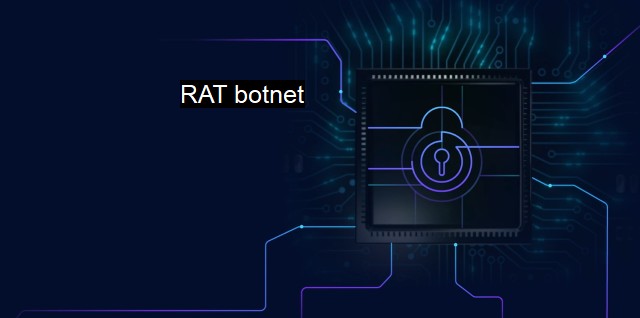What is RAT botnet?
RAT Botnet Unleashed: Exploring the Marriage of Automation and Persistence in Cyberattacks
A Remote Access Trojan (RAT) botnet is a covert network of machines infected with malware that gives a malicious user control over those systems from a remote location. It combines two degrees of cyber threats: RATs and botnets. Boasting an influential scope in current cyberspace operations, it has become an increasing concern in the cybersecurity domain, fueling an urgent need for robust antivirus strategies.Understanding both concepts – RATs and botnets – isolates what makes a RAT botnet so significant for analysis. A RAT is a type of malware that escalates privileges on a machine to give an intruder control over it – it's like unlocking the front door to that device. Once inside this virtual 'door,' the invader can perform a series of functions, ranging from tampering with system files to exploiting user information. RATs are generally introduced into a system via seemingly harmless downloads such as emails attachments or bundled software, subsequently propagating throughout the network.
Botnets, on the other hand, represent a network of internet-connected devices infected with a particular type of malicious software payload. Thus, the device becomes a 'bot,' ensnared within the command and control sphere of the malware generator. A botnet can comprise thousands, if not millions, of machines, linking together personal computers, mobile devices, or even IoT endpoints, leveraged to conduct a wide range of nefarious activities: mass spamming, DDos attacks, cryptocurrency mining, or data breaches.
A RAT botnet, then, is an interconnected web of infected devices controlled via Remote Access Trojans—a virtual army amassed by hackers, silently marshalling computing resources, and personal data. This twofold threat presents amplified power for cyber-criminals, compounding the consequences of systemic invasions. While RAT provides remote access to individual systems, the accompanying botnet empowers the threat actor to mobilize multiple infected devices simultaneously.
Cybercriminals favor RAT botnets due to their ability to go unnoticed. Sophisticated RATs can hide their processes and files, allowing them to avoid detection by standard antivirus software, persistently lurking in systems, undisturbed and operational. The covert aspect of RAT botnets links with two critical facets of cyber warfare: stealth and persistence. Maintained over a prolonged period, these botnets can wreak substantial havoc on the targeted infrastructure and extract a staggering amount of sensitive data.
The realization of this threat, therefore, posits a critical role for powerful antivirus software necessary to successfully thwart these cyber threats. To combat RAT botnets effectively, antivirus systems must go beyond scanning for known threats. Behavioral-based detection designs are fundamental in identifying cloaked botnets, quantum-based secure cyber infrastructures to enable proactive defenses against botnet invasions, and machine learning algorithms to learn and adapt to emerging threats.
It's vital for antivirus solutions not just to aim at detection but also to concentrate on prevention, immediate system quarantine, and efficient removal processes. It includes conducting continuous system scans, monitoring unusual network activity, keeping software up to date, instating strong and unique passwords, and leveraging a solid firewall—a collective effort to keep RAT botnets under control.
Undeniably, the creation and control of RAT botnets make a formidable arsenal in the digital weaponry of today’s cyber criminals. Accordingly, fighting this battle effectively calls for not only increasingly nimble and complex cybersecurity technology at the disposal of defense forces, but also a basic awareness among internet users of safe browsing habits, and the threats that lurk deceptively around the corners of the World Wide Web. It's beyond doubt that the dynamics of cybersecurity are becoming increasingly sophisticated, and an efficient antivirus solution against RAT botnets underpins our collective defense strategies.

RAT botnet FAQs
What is a rat botnet?
A rat botnet is a network of computers that have been infected with remote access trojans (RATs) and can be controlled by a hacker or cybercriminal to launch attacks or carry out malicious activities.How do rat botnets work?
Rat botnets work by infecting computers with malware that allows a hacker to remotely control them. Once infected, the botnet can be used for a variety of malicious purposes, including stealing data, launching DDoS attacks, and spreading viruses or ransomware.How can I protect myself from rat botnets?
To protect yourself from rat botnets, you should always keep your antivirus software up-to-date, avoid clicking on suspicious links or downloading unknown files, and regularly scan your computer for malware. It's also important to use strong passwords and enable two-factor authentication on all your accounts.What should I do if I suspect my computer is part of a rat botnet?
If you suspect your computer is part of a rat botnet, you should immediately disconnect it from the internet and run a full scan with your antivirus software. You should also change all your passwords and enable two-factor authentication on your accounts. If you are still concerned, consider getting a professional cybersecurity assessment or consulting with an expert.| | A | | | B | | | C | | | D | | | E | | | F | | | G | | | H | | | I | | | J | | | K | | | L | | | M | |
| | N | | | O | | | P | | | Q | | | R | | | S | | | T | | | U | | | V | | | W | | | X | | | Y | | | Z | |
| | 1 | | | 2 | | | 3 | | | 4 | | | 7 | | | 8 | | |||||||